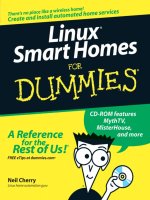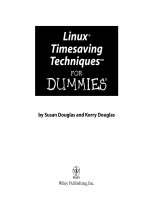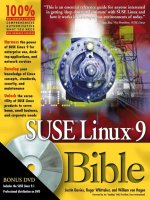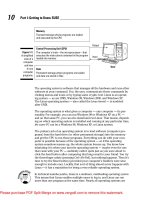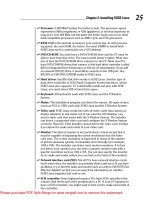SUSE linux 9 3 for dummies
Bạn đang xem bản rút gọn của tài liệu. Xem và tải ngay bản đầy đủ của tài liệu tại đây (10.64 MB, 387 trang )
www.dbeBooks.com - An Ebook Library
SUSE Linux 9.3
®
FOR
DUMmIES
‰
by Naba Barkakati
SUSE Linux 9.3
®
FOR
DUMmIES
‰
SUSE Linux 9.3
®
FOR
DUMmIES
‰
by Naba Barkakati
®
®
SUSE Linux 9.3 For Dummies
Published by
Wiley Publishing, Inc.
111 River Street
Hoboken, NJ 07030-5774
www.wiley.com
Copyright © 2005 by Wiley Publishing, Inc., Indianapolis, Indiana
Published by Wiley Publishing, Inc., Indianapolis, Indiana
Published simultaneously in Canada
No part of this publication may be reproduced, stored in a retrieval system or transmitted in any form or
by any means, electronic, mechanical, photocopying, recording, scanning or otherwise, except as permitted under Sections 107 or 108 of the 1976 United States Copyright Act, without either the prior written
permission of the Publisher, or authorization through payment of the appropriate per-copy fee to the
Copyright Clearance Center, 222 Rosewood Drive, Danvers, MA 01923, (978) 750-8400, fax (978) 646-8600.
Requests to the Publisher for permission should be addressed to the Legal Department, Wiley Publishing,
Inc., 10475 Crosspoint Blvd., Indianapolis, IN 46256, (317) 572-3447, fax (317) 572-4355, or online at
/>Trademarks: Wiley, the Wiley Publishing logo, For Dummies, the Dummies Man logo, A Reference for the
Rest of Us!, The Dummies Way, Dummies Daily, The Fun and Easy Way, Dummies.com, and related trade
dress are trademarks or registered trademarks of John Wiley & Sons, Inc. and/or its affiliates in the United
States and other countries, and may not be used without written permission. Linux is a registered trademark of Linus Torvalds. All other trademarks are the property of their respective owners. Wiley
Publishing, Inc., is not associated with any product or vendor mentioned in this book.
LIMIT OF LIABILITY/DISCLAIMER OF WARRANTY: THE PUBLISHER AND THE AUTHOR MAKE NO REPRESENTATIONS OR WARRANTIES WITH RESPECT TO THE ACCURACY OR COMPLETENESS OF THE
CONTENTS OF THIS WORK AND SPECIFICALLY DISCLAIM ALL WARRANTIES, INCLUDING WITHOUT
LIMITATION WARRANTIES OF FITNESS FOR A PARTICULAR PURPOSE. NO WARRANTY MAY BE CREATED OR EXTENDED BY SALES OR PROMOTIONAL MATERIALS. THE ADVICE AND STRATEGIES CONTAINED HEREIN MAY NOT BE SUITABLE FOR EVERY SITUATION. THIS WORK IS SOLD WITH THE
UNDERSTANDING THAT THE PUBLISHER IS NOT ENGAGED IN RENDERING LEGAL, ACCOUNTING, OR
OTHER PROFESSIONAL SERVICES. IF PROFESSIONAL ASSISTANCE IS REQUIRED, THE SERVICES OF A
COMPETENT PROFESSIONAL PERSON SHOULD BE SOUGHT. NEITHER THE PUBLISHER NOR THE
AUTHOR SHALL BE LIABLE FOR DAMAGES ARISING HEREFROM. THE FACT THAT AN ORGANIZATION
OR WEBSITE IS REFERRED TO IN THIS WORK AS A CITATION AND/OR A POTENTIAL SOURCE OF FURTHER INFORMATION DOES NOT MEAN THAT THE AUTHOR OR THE PUBLISHER ENDORSES THE
INFORMATION THE ORGANIZATION OR WEBSITE MAY PROVIDE OR RECOMMENDATIONS IT MAY
MAKE. FURTHER, READERS SHOULD BE AWARE THAT INTERNET WEBSITES LISTED IN THIS WORK
MAY HAVE CHANGED OR DISAPPEARED BETWEEN WHEN THIS WORK WAS WRITTEN AND WHEN IT
IS READ. FULFILLMENT OF EACH COUPON OFFER IS THE SOLE RESPONSIBILITY OF THE OFFEROR.
For general information on our other products and services, please contact our Customer Care
Department within the U.S. at 800-762-2974, outside the U.S. at 317-572-3993, or fax 317-572-4002.
For technical support, please visit www.wiley.com/techsupport.
Wiley also publishes its books in a variety of electronic formats. Some content that appears in print may
not be available in electronic books.
Library of Congress Control Number: 2005923238
ISBN-13: 978-07645-9615-5
ISBN-10: 0-7645-9615-2
Manufactured in the United States of America
10 9 8 7 6 5 4 3 2 1
1B/QT/QV/QV/IN
About the Author
Naba Barkakati is an electrical engineer and a successful computer-book
author who has experience in a wide variety of systems, ranging from
MS-DOS and Windows to UNIX and Linux. He bought his first personal
computer — an IBM PC-AT — in 1984 after graduating with a PhD in electrical
engineering from the University of Maryland at College Park. While pursuing
a full-time career in engineering, Naba dreamed of writing software for the
emerging PC software market. As luck would have it, instead of building a
software empire like Microsoft, he ended up writing successful computer
books. Currently, Naba is a Senior Level Technologist at the Center for
Technology and Engineering in the U.S. Government Accountability
Office (GAO).
Over the past 16 years, Naba has written over 25 computer books on a
number of topics, ranging from object-oriented programming with C++ to
Linux. He has authored several best-selling titles, such as The Waite Group’s
Turbo C++ Bible, Object-Oriented Programming in C++, X Window System
Programming, Visual C++ Developer’s Guide, Borland C++ 4 Developer’s Guide,
and Linux Secrets. His books have been translated into many languages,
including Spanish, French, Polish, Greek, Italian, Chinese, Japanese, and
Korean. Naba’s most recent book is Linux All-in-One Desk Reference For
Dummies, also published by Wiley Publishing, Inc.
Naba lives in North Potomac, Maryland, with his wife Leha, and their children, Ivy, Emily, and Ashley.
Dedication
I would like to dedicate this book to my wife Leha, and daughters Ivy, Emily,
and Ashley.
Author’s Acknowledgments
I am grateful to Terri Varveris for getting me started on this book — a For
Dummies guide about the up and coming SUSE Linux. As the project editor,
Linda Morris guided me through the manuscript-submission process and
kept everything moving. I appreciate the guidance and support that Terri and
Linda gave me during this project.
I would like to thank Susan Douglas for reviewing the manuscript for technical accuracy and providing many useful suggestions for improving the book’s
content.
Thanks to everyone at Wiley Publishing for transforming my raw manuscript
into this well-edited and beautifully packaged book.
Of course, there would be no reason for this book if it were not for Linux. For
this, we have Linus Torvalds and the legions of Linux developers around the
world to thank. Thanks to Christian Egle, Andreas Jaeger, and others at
Novell for providing beta copies of SUSE Linux and for the Special Edition
DVD that’s bundled with this book.
Finally, and as always, my greatest thanks go to my wife, Leha, and our
daughters, Ivy, Emily, and Ashley — it is their love and support that keeps me
going. Thanks for being there!
Publisher’s Acknowledgments
We’re proud of this book; please send us your comments through our online registration form
located at www.dummies.com/register/.
Some of the people who helped bring this book to market include the following:
Acquisitions, Editorial,
and Media Development
Composition Services
Project Editor: Linda Morris
Acquisitions Editor: Terri Varveris
Copy Editor: Linda Morris
Technical Editor: Susan Douglas
Editorial Manager: Carol Sheehan
Media Development Manager:
Laura VanWinkle
Project Coordinator: Shannon Kepshire
Layout and Graphics: Carl Byers, Andrea Dahl,
Lauren Goddard, Joyce Haughey,
Heather Ryan
Proofreaders: Leeann Harney, Jessica Kramer,
Carl William Pierce, Charles Spencer,
TECHBOOKS Production Services
Indexer: TECHBOOKS Production Services
Media Development Supervisor:
Richard Graves
Editorial Assistant: Amanda Foxworth
Cartoons: Rich Tennant, www.the5thwave.com
Publishing and Editorial for Technology Dummies
Richard Swadley, Vice President and Executive Group Publisher
Andy Cummings, Vice President and Publisher
Mary Bednarek, Executive Acquisitions Director
Mary C. Corder, Editorial Director
Publishing for Consumer Dummies
Diane Graves Steele, Vice President and Publisher
Joyce Pepple, Acquisitions Director
Composition Services
Gerry Fahey, Vice President of Production Services
Debbie Stailey, Director of Composition Services
Contents at a Glance
Introduction .................................................................1
Part I: Getting to Know SUSE ........................................7
Chapter 1: What Is SUSE Linux?........................................................................................9
Chapter 2: Installing SUSE Linux.....................................................................................23
Chapter 3: Starting SUSE for the First Time ..................................................................39
Chapter 4: Taking Stock of What’s in SUSE ...................................................................55
Part II: Test Driving SUSE ...........................................63
Chapter 5: Exploring the SUSE Desktops.......................................................................65
Chapter 6: Finding and Organizing Files........................................................................81
Chapter 7: I Want My Internet, Now! ............................................................................105
Chapter 8: Setting Up an Ethernet LAN with Wireless Access..................................123
Part III: Doing Stuff with SUSE .................................139
Chapter 9: Browsing the Web........................................................................................141
Chapter 10: E-Mailing and Instant Messaging in SUSE...............................................155
Chapter 11: Reading Newsgroups ................................................................................169
Chapter 12: Preparing Documents and Spreadsheets in SUSE Linux ......................183
Chapter 13: Doing Even More Office Stuff in SUSE Linux ..........................................205
Chapter 14: Playing Music and Burning CDs...............................................................217
Chapter 15: Working with Photos and Images............................................................227
Chapter 16: What’s a Shell and Why Do I Care?..........................................................243
Part IV: Becoming a SUSE Wizard..............................253
Chapter 17: Look Ma, I’m a Sysadmin! .........................................................................255
Chapter 18: Updating SUSE and Adding New Software .............................................273
Chapter 19: Securing SUSE Linux .................................................................................287
Part V: The Part of Tens ............................................309
Chapter 20: Ten Frequently Asked Questions about SUSE .......................................311
Chapter 21: The Ten Best Things about SUSE ............................................................321
Chapter 22: Ten Great Web Sites for SUSE Maniacs ...................................................327
Chapter 23: Ten Most Commonly Used SUSE Commands.........................................331
Appendix: About the DVD-ROM....................................................................................341
Index .......................................................................345
Table of Contents
Introduction..................................................................1
About This Book...............................................................................................2
Conventions Used in This Book .....................................................................2
What You Don’t Have to Read ........................................................................3
Who Are You? ...................................................................................................3
How This Book Is Organized...........................................................................3
What’s on the DVD? .........................................................................................4
Icons Used in This Book..................................................................................4
Where to Go from Here....................................................................................5
Part I: Getting to Know SUSE .........................................7
Chapter 1: What Is SUSE Linux? . . . . . . . . . . . . . . . . . . . . . . . . . . . . . . . . .9
Getting a Handle on Linux...............................................................................9
Discovering SUSE Linux.......................................................................12
Making sense of Linux version numbers ...........................................12
What’s in SUSE Linux? ...................................................................................13
GNU software ........................................................................................13
GUIs and applications ..........................................................................14
Networks ...............................................................................................15
Internet servers ....................................................................................16
Software development .........................................................................16
Online documentation .........................................................................17
Figuring Out What You Can Do with SUSE Linux........................................17
Disks, CD-ROMs, and DVD-ROMs .......................................................19
Peripheral devices................................................................................19
File systems and sharing .....................................................................20
Networking ............................................................................................20
Getting Started with SUSE Linux ..................................................................21
Install and configure SUSE Linux ........................................................21
Explore SUSE Linux ..............................................................................22
Use SUSE Linux .....................................................................................22
Chapter 2: Installing SUSE Linux . . . . . . . . . . . . . . . . . . . . . . . . . . . . . . .23
Introducing the Installation Steps................................................................23
Checking Your PC’s Hardware ......................................................................24
Installing SUSE Linux .....................................................................................26
Booting your PC from the DVD/CD-ROM drive.................................26
Installing SUSE Linux from CDs or DVD.............................................26
xii
SUSE Linux 9.3 For Dummies
Chapter 3: Starting SUSE for the First Time . . . . . . . . . . . . . . . . . . . . . .39
Powering Up SUSE Linux ...............................................................................39
Getting GUI ......................................................................................................41
Setting Up Printers.........................................................................................45
Managing DVDs and CD-ROMs .....................................................................48
Playing with the Shell ....................................................................................48
Starting the bash shell .........................................................................48
Understanding shell commands.........................................................49
Trying a few Linux commands............................................................50
Shutting Down ................................................................................................52
Chapter 4: Taking Stock of What’s in SUSE . . . . . . . . . . . . . . . . . . . . . .55
Discovering the Internet Applications ........................................................55
Introducing the Office Applications.............................................................57
Exploring the Multimedia Applications.......................................................58
Cataloging the Image and Graphics Applications ......................................60
Part II: Test Driving SUSE ............................................63
Chapter 5: Exploring the SUSE Desktops . . . . . . . . . . . . . . . . . . . . . . . .65
Discovering the Common Features of the Desktops .................................65
Desktop context menus .......................................................................67
Icon context menus..............................................................................68
The panels .............................................................................................69
The Main Menu or Programs Menu....................................................70
Exploring KDE.................................................................................................74
Getting to Know GNOME ...............................................................................76
Chapter 6: Finding and Organizing Files . . . . . . . . . . . . . . . . . . . . . . . . .81
Figuring Out the Linux File System ..............................................................81
Using GUI File Managers................................................................................85
Conquering the file system with Konqueror.....................................85
Roaming the file system with Nautilus ..............................................88
Using Linux Commands to Manipulate Files and Directories...................93
Commands for directory navigation..................................................94
Commands for directory listings and permissions..........................95
Commands for working with files.......................................................98
Commands for working with directories...........................................99
Commands for finding files ...............................................................100
Commands for mounting and unmounting .....................................101
Commands for checking disk-space usage .....................................102
Chapter 7: I Want My Internet, Now! . . . . . . . . . . . . . . . . . . . . . . . . . . .105
What Is the Internet? ...................................................................................105
Deciding How to Connect to the Internet .................................................106
Table of Contents
Connecting to the Internet with DSL .........................................................108
How DSL works ...................................................................................108
Stirring the DSL alphabet soup: ADSL, IDSL, SDSL.........................110
Typical DSL setup...............................................................................110
Connecting to the Internet with a Cable Modem .....................................114
How cable modems work ..................................................................114
Typical cable modem setup ..............................................................116
Dialing Up the Internet ................................................................................119
Connecting the modem .....................................................................120
Configuring the modem .....................................................................121
Chapter 8: Setting Up an Ethernet LAN with Wireless Access . . . . .123
Getting a Handle on Ethernet .....................................................................123
Connecting PCs to an Ethernet LAN ..........................................................124
Configuring the Ethernet Network .............................................................125
Connecting Your LAN to the Internet ........................................................126
Extending Your LAN with a Wireless Network .........................................128
Understanding wireless Ethernet networking ................................128
Understanding infrastructure and ad hoc modes ..........................129
Understanding Wired Equivalent Privacy (WEP) ...........................130
Setting up the wireless hardware .....................................................130
Configuring the wireless access point .............................................131
Configuring wireless networking......................................................132
Checking whether Your Network Is Up .....................................................135
Checking the network interfaces......................................................135
Checking the IP routing table............................................................136
Checking connectivity to a host .......................................................136
Part III: Doing Stuff with SUSE ..................................139
Chapter 9: Browsing the Web . . . . . . . . . . . . . . . . . . . . . . . . . . . . . . . . .141
Understanding the World Wide Web .........................................................142
Links and URLs ...................................................................................142
Web servers and Web browsers .......................................................145
Web Browsing in SUSE Linux ......................................................................146
Web Browsing with Konqueror in KDE......................................................147
Web Browsing with Mozilla in GNOME......................................................149
Getting familiar with the Mozilla interface......................................150
Changing your home page.................................................................152
Introducing Epiphany and Firefox..............................................................153
Chapter 10: E-Mailing and Instant Messaging in SUSE . . . . . . . . . . .155
Understanding E-Mail ..................................................................................156
How MUA and MTA work...................................................................156
Mail message enhancements ............................................................157
xiii
xiv
SUSE Linux 9.3 For Dummies
E-Mailing in SUSE Linux ...............................................................................158
Introducing KMail ...............................................................................158
Introducing Evolution Mail................................................................160
Instant Messaging in SUSE Linux................................................................163
Using Kopete .......................................................................................164
Using GAIM..........................................................................................166
Chapter 11: Reading Newsgroups . . . . . . . . . . . . . . . . . . . . . . . . . . . . .169
Understanding Newsgroups .......................................................................169
Newsgroup hierarchy.........................................................................170
Top-level newsgroup categories.......................................................171
Some Linux-related newsgroups.......................................................172
Reading Newsgroups from Your ISP ..........................................................173
Taking stock of newsreaders in SUSE Linux....................................174
Introducing KNode .............................................................................174
Introducing Pan ..................................................................................177
Newsgroup subscriptions .................................................................179
Posting news .......................................................................................179
Reading and Searching Newsgroups at Web Sites ...................................180
Chapter 12: Preparing Documents
and Spreadsheets in SUSE Linux . . . . . . . . . . . . . . . . . . . . . . . . . . . . . .183
Writing with OpenOffice.org Writer ...........................................................183
Taking stock of OpenOffice.org Writer ............................................184
Getting started with Writer ...............................................................185
Setting up Writer.................................................................................187
Preparing documents in Writer ........................................................187
Editing and reviewing documents....................................................188
Using styles and templates ...............................................................189
Doing page layout...............................................................................192
Creating and inserting graphics .......................................................194
Using fields ..........................................................................................195
Working with large documents .........................................................196
Preparing Spreadsheets with OpenOffice.org Calc..................................197
Taking stock of OpenOffice.org Calc ................................................197
Getting started with Calc...................................................................198
Entering and formatting data............................................................201
Calculating and charting data...........................................................201
Chapter 13: Doing Even More Office Stuff in SUSE Linux . . . . . . . . .205
Keeping Track of Appointments and Tasks ..............................................205
Making Calculations.....................................................................................207
Making Presentations with OpenOffice.org Impress ...............................208
Taking stock of OpenOffice.org Impress..........................................208
Getting started with Impress ............................................................209
Using Impress......................................................................................212
Table of Contents
Preparing presentations ....................................................................213
Adding graphics and special effects ................................................215
Delivering presentations ...................................................................216
Chapter 14: Playing Music and Burning CDs . . . . . . . . . . . . . . . . . . . .217
Playing Audio CDs........................................................................................217
Playing Music Files.......................................................................................219
Burning a CD/DVD........................................................................................221
Burning CD/DVDs with K3b...............................................................221
Burning data CDs in Nautilus............................................................225
Chapter 15: Working with Photos and Images . . . . . . . . . . . . . . . . . . .227
Downloading Photos from a Digital Camera.............................................228
Scanning Photos and Documents ..............................................................232
Editing Images with The GIMP....................................................................237
Viewing Images .............................................................................................239
Viewing PDF and PostScript Files...............................................................241
Chapter 16: What’s a Shell and Why Do I Care? . . . . . . . . . . . . . . . . . .243
Opening Terminal Windows and Virtual Consoles ..................................243
Exploring the Bash Shell .............................................................................244
Understanding the syntax of shell commands ...............................245
Combining shell commands..............................................................246
Controlling command input and output..........................................246
Typing less with automatic command completion........................248
Going wild with asterisks and question marks...............................248
Repeating previously typed commands ..........................................250
Part IV: Becoming a SUSE Wizard ..............................253
Chapter 17: Look Ma, I’m a Sysadmin! . . . . . . . . . . . . . . . . . . . . . . . . . .255
What Does a Sysadmin Do?.........................................................................255
Becoming root, When You Must.................................................................257
Resetting a Forgotten root Password ........................................................257
Introducing Your New Friend, YaST ...........................................................259
Starting and Stopping Services ..................................................................261
Understanding how Linux boots ......................................................261
Trying a new run level with the init command...............................263
Using YaST to start and stop services .............................................264
Manually starting and stopping services ........................................264
Checking Your System’s Performance.......................................................265
Using the top utility ...........................................................................265
xv
xvi
SUSE Linux 9.3 For Dummies
Using the uptime command ..............................................................267
Checking disk performance and disk usage....................................268
Managing Hardware Devices ......................................................................269
Managing User Accounts.............................................................................270
Chapter 18: Updating SUSE and Adding New Software . . . . . . . . . . .273
Updating SUSE Linux Online .......................................................................274
Locating and Installing Software Using YaST............................................277
Using RPM Commands to Work with RPM Files.......................................280
Using the RPM commands ................................................................281
Understanding RPM filenames..........................................................281
Querying RPMs ...................................................................................282
Installing an RPM................................................................................284
Removing an RPM ..............................................................................285
Upgrading an RPM..............................................................................285
Chapter 19: Securing SUSE Linux . . . . . . . . . . . . . . . . . . . . . . . . . . . . . .287
Why Worry about Security?........................................................................287
Understanding Linux Security ....................................................................288
Understanding the host security issues..........................................288
Understanding network security issues..........................................289
Getting Familiar with Computer Security Terminology ..........................290
Practicing Good Host Security ...................................................................295
Making passwords expire..................................................................295
Protecting files and directories ........................................................296
Securing the Network ..................................................................................300
Securing Internet services.................................................................301
Turning off stand-alone services ......................................................301
Configuring the Internet superserver ..............................................301
Configuring TCP wrapper security...................................................302
Using Secure Shell (SSH) for remote logins.....................................303
Setting up a simple firewall ...............................................................304
Using NATs...........................................................................................307
Keeping Up with Security News and Updates ..........................................308
Part V: The Part of Tens .............................................309
Chapter 20: Ten Frequently Asked Questions about SUSE . . . . . . . . .311
What Does SUSE Stand for and How Do You Pronounce It? ...................311
How Can I Find Answers to My SUSE Linux Questions?..........................312
When Is the Next SUSE Linux Release?......................................................312
Can I Get ISO Files for SUSE Linux from the Internet? .............................313
Table of Contents
How Do I Do an FTP Install of SUSE Linux? ...............................................313
How Can I Auto-Login into the KDE Desktop as Another User?.............316
If My System Crashes, Can I Press the Reset Button to Reboot? ...........318
How Can I Schedule a Command to Run Every 30 Minutes? ..................318
How Can I Find All the Huge Files on My SUSE Linux System?...............319
Where Can I Find More SUSE RPMs?..........................................................320
Chapter 21: The Ten Best Things about SUSE . . . . . . . . . . . . . . . . . . .321
YaST — The Super Sysadmin Tool .............................................................321
Detects All Hardware (Well, Nearly All!)....................................................322
Smooth and Easy Installation .....................................................................322
I Love YOU — YaST Online Update............................................................323
Automatic Mounting of My Windows
Partitions and USB Memory Stick ..........................................................323
Automatic Login at the KDE Desktop ........................................................324
Good Support for Laptops ..........................................................................324
Easy Browsing of Windows Shares ............................................................324
That Cute Gecko Mascot .............................................................................324
SUSE’s Increasing Popularity ......................................................................325
Chapter 22: Ten Great Web Sites for SUSE Maniacs . . . . . . . . . . . . .327
...................................................................................327
...............................................328
/> ........................................................................328
/> /> ......................................................................329
..................................................................329
....................................................................................330
...............................................................330
Chapter 23: Ten Most Commonly Used SUSE Commands . . . . . . . . .331
apropos: Finding Commands Based on a Keyword .................................332
man: Reading Online Man Page ..................................................................332
ls: Listing Files and Directories ..................................................................333
cat: Feeding Input to Commands ...............................................................333
grep: Searching for Text in Files .................................................................334
locate: Finding Files and Directories the Easy Way .................................335
chmod: Changing Permissions ...................................................................336
rpm: Taming RPM Packages........................................................................337
tar: Packing and Unpacking Archives ........................................................337
pico: Editing Text Files ................................................................................339
xvii
xviii
SUSE Linux 9.3 For Dummies
Appendix: About the DVD-ROM . . . . . . . . . . . . . . . . . . . . . . . . . . . . . . .341
System Requirements ..................................................................................341
DVD Installation Instructions .....................................................................342
What You’ll Find on the DVD ......................................................................343
Troubleshooting ...........................................................................................344
Index........................................................................345
Introduction
S
USE Linux is an increasingly popular Linux distribution that competes
head-on with Red Hat’s Linux versions. SUSE Linux’s fortunes have been
on the rise following Novell’s acquisition of Germany’s SUSE Linux AG for
$210 million. SUSE is looking for more growth in the U.S. marketplace, helped
in part by IBM’s $50 million investment in Novell as part of the SUSE acquisition deal. On another positive note, after acquiring SUSE, Novell announced
that SUSE’s famous YaST installation and configuration tool will become open
source, licensed under the GNU General Public License. All these developments have generated a distinct “buzz” around SUSE Linux as the up-andcoming Linux distribution for everyone from home users to enterprise
servers.
A significant factor in SUSE Linux’s increasing popularity is that unlike its competitor Red Hat’s singular focus on the enterprise market, Novell continues
to address both the enterprise market and Linux enthusiasts. Specifically, the
SUSE Linux Professional product is aimed at small-office/home-office users
as well as those wishing to experiment with the SUSE Linux as their desktop
system. SUSE Linux Professional is sold as boxed sets through distributors as
well as online stores. SUSE Linux Professional with a typical retail price tag of
$89.95 (with lower prices for students and for those updating from a previous
version) is a complete Linux distribution, suitable for small office/home office
or even an enterprise. This book includes a DVD with a Special Edition version
of SUSE Linux Professional, with everything you need to use it as a personal
desktop system. This book also includes a coupon that you can use to purchase a copy of the full SUSE Linux Professional distribution.
If you are starting out with SUSE Linux, you need a beginner’s guide that not
only gets you going with the installation and setup of SUSE Linux, but also
shows you how to use all the tools that come with your desktop. That’s why
I wrote SUSE Linux 9.3 For Dummies in plain English, using a breezy style, that
quickly gets to the step-by-step instructions for accomplishing a task, be it
installing a printer or crafting a memo with OpenOffice.org Writer. My goal
is to minimize confusion and keep things as simple as possible. I present the
essential steps for specific tasks, but avoid inundating you with too many
details.
2
SUSE Linux 9.3 For Dummies
About This Book
SUSE Linux 9.3 For Dummies is a beginner’s guide for the upcoming SUSE
Linux distribution. The approach to the subject matter and the writing style
is that of the successful For Dummies series. The focus is on introducing
you to the SUSE Linux desktop with all the GUI tools, including the office productivity suite (OpenOffice.org) and multimedia applications (audio player,
digital camera, CD burning, image editing, and so on). I include a chapter on
connecting to the Internet using cable/DSL modems and setting up a basic
home network because these have become necessities for anyone who has
more than one PC and, especially, for those who plan to run SUSE Linux on a
PC. I also include a part that introduces the basics of routine system administration, how to add and update software, and how to tighten up the system’s
security.
Here are some of the things that this book shows you how to do:
ߜ Install and configure SUSE Linux from the DVD-ROM included with the
book.
ߜ Connect the SUSE Linux system to the Internet through a DSL or cable
modem.
ߜ Set up dialup networking.
ߜ Add a wireless Ethernet to your existing network.
ߜ Get tips, techniques, and shortcuts for various uses of SUSE Linux,
such as
• Using the OpenOffice.org office suite
• Browsing the Linux file system
• Using Linux commands
• Using multimedia applications
ߜ Understand the basics of system and network security.
ߜ Perform system administration tasks.
Conventions Used in This Book
I use a simple notational style in this book. All listings, filenames, commands,
and keywords are typeset in a monospace font for ease of reading. I italicize
the first occurrences of new terms and concepts, and then provide a definition right there. I show typed commands in boldface. The output of commands and any listing of files is shown in a monospace font.
Introduction
What You Don’t Have to Read
Each chapter zeros in on a specific task area — such as using the Internet
or preparing documents with OpenOffice.org — and then provides hands-on
instructions on how to perform a series of related tasks. You can jump right
to a section and read about a specific task. You don’t have to read anything
but the few paragraphs or the list of steps that relate to your question. Use the
Table of Contents or the Index to locate the pages relevant to your question.
You can safely ignore text next to the Technical Stuff icons as well as the sidebars. However, if you are the kind who likes to know some of the hidden details
of how Linux works, by all means, dig into the Technical Stuff and the sidebars.
Who Are You?
I assume that you are somewhat familiar with a PC — you know how to turn it
on and off and you have dabbled a bit with Windows. Considering that most
new PCs come preloaded with Windows, this assumption is safe, right? And I
assume that you know how to use some of the Windows applications such as
Microsoft Office. Most of all, you want to either experiment with or switch to
SUSE Linux as your desktop of choice.
When installing SUSE Linux on your PC, you may want to retain your
Windows 2000 or Windows XP installations. I assume that you are willing
to accept the risk that when you try to install SUSE Linux, some things may
not quite work. Problems can happen if you have some uncommon types of
hardware. If you are afraid of ruining your system, try finding a slightly older
spare Pentium PC that you can sacrifice and then install Linux on that PC.
How This Book Is Organized
SUSE Linux 9.3 For Dummies contains 23 chapters organized into five parts.
The book’s organization is that of a typical For Dummies title that covers an
operating system such as SUSE Linux where the reader is expected to install
the software and then learn to use it. The five parts cover installation and
setup, test driving the system to learn the ropes, using the system to do
productive work, learning to be a budding system administrator, and the
mandatory “Part of Tens.” Here’s a quick overview of the five parts and the
appendix:
ߜ Part I: Getting to Know SUSE introduces the reader to SUSE Linux, provides step-by-step installation instructions, and explains what happens
when you start the system for the first time.
3
4
SUSE Linux 9.3 For Dummies
ߜ Part II: Test Driving SUSE is about getting started with SUSE Linux —
how to use the desktop and the file manager, how to connect to the
Internet (and set up a home network), and figuring out what else is there
to play with.
ߜ Part III: Doing Stuff with SUSE turns to doing day-to-day things with the
SUSE Linux system such as browsing the Web, reading e-mail and newsgroups, using the OpenOffice.org office suite and some multimedia applications, and, finally, working with the command line shell.
ߜ Part IV: Becoming a SUSE Wizard includes chapters on the basic system
administration and security. In particular, Part IV explains how to add
new software and keep the SUSE system up to date with the YaST (Yet
another Setup Tool) installation/configuration tool and YaST Online
Update (YOU).
ߜ Part V: The Part of Tens is the standard Part of Tens with chapters that
present ten frequently asked questions about SUSE, ten best things
about SUSE, ten great SUSE-related Web sites, and ten most commonly
used SUSE Linux commands.
ߜ Appendix: About the DVD-ROM summarizes the contents of the book’s
companion DVD-ROM.
What’s on the DVD?
The DVD contains a Special Edition version of SUSE Linux 9.3 Professional.
You may use the DVD in accordance with the license agreements accompanying the software. To find out more about the contents of the DVD, please consult the appendix.
Sidebars
Sometimes I use sidebars to highlight interesting, but not critical, information. Sidebars explain
concepts you may not have encountered before
or give a little insight into a related topic. If you’re
in a hurry, you can safely skip the sidebars.
